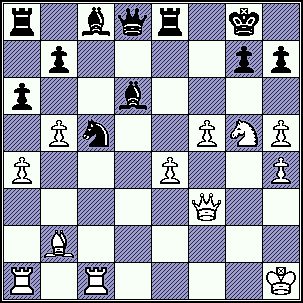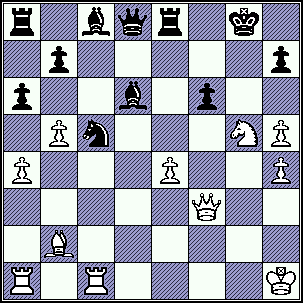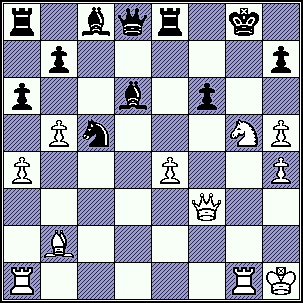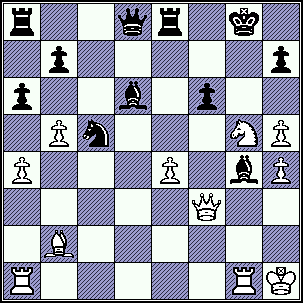All
the |
(Navigation bar
directly below.)
*******
© A.J. Goldsby, 2015.
(All rights reserved.)
****************
Click HERE
to see my
Chess Items.
****************
****************
Buy a book
from Amazon.com
(And help me out as well!)
****************
Click HERE
...
to see a list of the businesses that help to sponsor all of
my chess efforts.
|
|
|---|
I don't normally give just positions for my Tactical School, but here I must make an exception.
This was a game that I witnessed on the Internet one day. (I was NOT one of the participants!)
I was waiting for a ride to a chess lesson. I was bored, and had a few minutes to kill. So I logged onto ICC and began observing a few of the games of a tournament in progress. I came across one that made a lasting impression on me.
Then my ride arrived. I hastily logged off the Internet and turned off my computer, I greatly regret not saving the game to my hard drive. (Its a fairly simple thing to do, if you understand the use of the interface/host-client program ... and the menu-driven windows environment.)
I was NOT able to re-create the whole game from memory, however, I did remember the key position ...
Master #01 (2460) -
Master #02 (2375)
|
 |
r1bqr1k1/1p4pp/p2b4/1Pn2PNP/P3P2P/5Q2/1B6/R1R4K w
(The starting position.)
The
position is one of unusual and incredible complexity ... it defies even the brute strength of the computers.
(At least this was true at the time
when I first analyzed this continuation! A.J.G. April, 2011.)
1.f6!!, (Why???)
The best move, and I saw this shot almost instantly. (The main idea of this shot is to rip up the home of Black's King. Black is virtually forced to take, and this exposes the Black Monarch on both the long diagonal AND the g-file as well!)
May 9th, 2006: I did a test today. I fired up Fritz 9, (under ChessBase); and gave it (a fat) 350 MB of RAM for the hash-tables. I asked the computer to provide TWO lines ... that it considered to be the best. It did NOT find 1.f6!! right away, and preferred (for the first 20-30 seconds) to examine 1.Rxc5! instead.
[ Also good for White was: 1.Rxc5! Bxc5; 2.f6!, "+/-" winning.
(This transposes to the main line of the solution here.)( Not as effective would be: 2.Qb3+!? Be6!; {Diagram?}
This is completely forced & best.(If the second player's King goes into the corner, you should quickly
see that Nf7+, followed by Nh6+ will result in the mating pattern of
the SMOTHERED MATE.)(</= 2...Kh8??; 3.Bxg7+!, "+/-")
3.fxe6, This is best.
( But NOT </= 3.Nxe6?? Qxh4+;
(Now Black's pieces enter the fray, and with devastating effect.)
4.Kg2 Qxe4+; ("-/+") and now Black is winning! )3...Re7; (Box?)
The machine indicates that this is pretty much forced for Black.** ** ** ** ** ** ** ** ** ** ** ** ** ** ** ** ** ** ** ** ** ** ** ** ** ** ** **
( Much worse would be:
</= 3...Qe7?; 4.Rf1! Rf8!?; 5.Rf7! Rxf7; 6.exf7+ Kh8[];
Absolutely the only move for Black in this position.(</= 6...Kf8??; 7.Nxh7#.)
7.h6, "+/-" Black's position is 100% lost. )
** ** ** ** ** ** ** ** ** ** ** ** ** ** ** ** ** ** ** ** ** ** ** ** ** ** ** **
4.Qc3 Qc7; 5.Nf7 Rxf7; 6.exf7+ Qxf7; 7.bxa6, '±'
and the first player is clearly better here.
(If 7...bxa6; then 8.h6 is practically winning for White.) ) ]
1...gxf6;
{See the diagram,
just below.}
This is obviously forced, Black cannot allow White to play this Pawn to f7, where it would fork King and Rook.
|
|
[ Much worse for Black is:
</= 1...Rf8?!; (Really - '?') 2.f7+ Kh8; 3.h6 Ne6; 4.Qf5!, "+/-"
and Black gets ripped to shreds.
(The machine shows mate in five moves or less.) ]
2.Rg1!!,
{See the
diagram given here, just below.}
This wins for White ... but is NOT the continuation that I had originally thought that White should play when examining the initial position.
|
|
[
The line that I thought was best for White was: 2.Rxc5!, BxR/c5; ('?')
3.Qb3+, Kg7;
4.Qf7+, followed by a mate on h7. ]
[ Also winning was: </= 2.Rxc5! Qe7; (Best/forced.)
( A gross alternative was: </= 2...fxg5?; 3.Rf1!! Bf4; 4.Qc3! Qe7[];
5.Rxg5+!, with a winning ("+/-") attack. (Mate in 10-15 moves,
or so says the box.) )3.e5!! fxe5!?;
The box shows that 3...Bg4 might be best for White, but this is not
how humans play chess.4.Rxe5!! Be6; Fritz shows this to be best/forced.
**********
( Even worse would be: </= 4...Bxe5?; 5.Qd5+ Kh8;
This could be forced.(Not </= 5...Be6?!; 6.Qxe5, "+/-" and Black is quickly mated.)
6.Bxe5+ Qxe5; 7.Nf7+ Kg7; 8.Nxe5, "+/-" winning easily. )
**********
5.Rg1!!, "+/-" with a scorching attack for White.
(Fritz already sees the mate!) ]
2...Bg4;
('[]') {See
the diagram given here, just below.}
The computer shows that this was pretty much forced.
|
|
[ After the continuation of:
</= 2...fxg5?!; 3.Raf1!! Rf8; 4.Qc3! Rf6; 5.Rxf6 Ne6; 6.Rf5!, "+/-"
and Black is rapidly mated. ]
I give the rest of the moves without comment or variations. (If you want to see the "why" of things, you will have to fire up your favorite program, and work it out on your own.)
3.Nxh7! Kh8;
4.Qxg4 Rg8; 5.Qf5 Be5; 6.Nxf6! Qe7[];
7.Bxe5 Nd3; 8.Bc3, "+/-"
White has a lop-sided position, Fritz is already showing mate in around ten (or so) moves from the position on the board.
Copyright (c) A.J. Goldsby, 2006. All rights reserved.
0
- 1
(In the actual game, White
misplayed his position and lost.)
Delve into these variations, and study them carefully! They show much about the nature of tactics ... and are the whole reason that I started my tactical school in the first place. {A.J.G.} 03/17/2006
(Page posted in March, 2006. Last update: Monday, April 14, 2014 11:14 AM .)
Click HERE to return to my home page.
Copyright (c) A.J. Goldsby I
Copyright (©) A.J. Goldsby, 1985-2013.
Copyright (©) A.J. Goldsby, 2014. All rights reserved.



